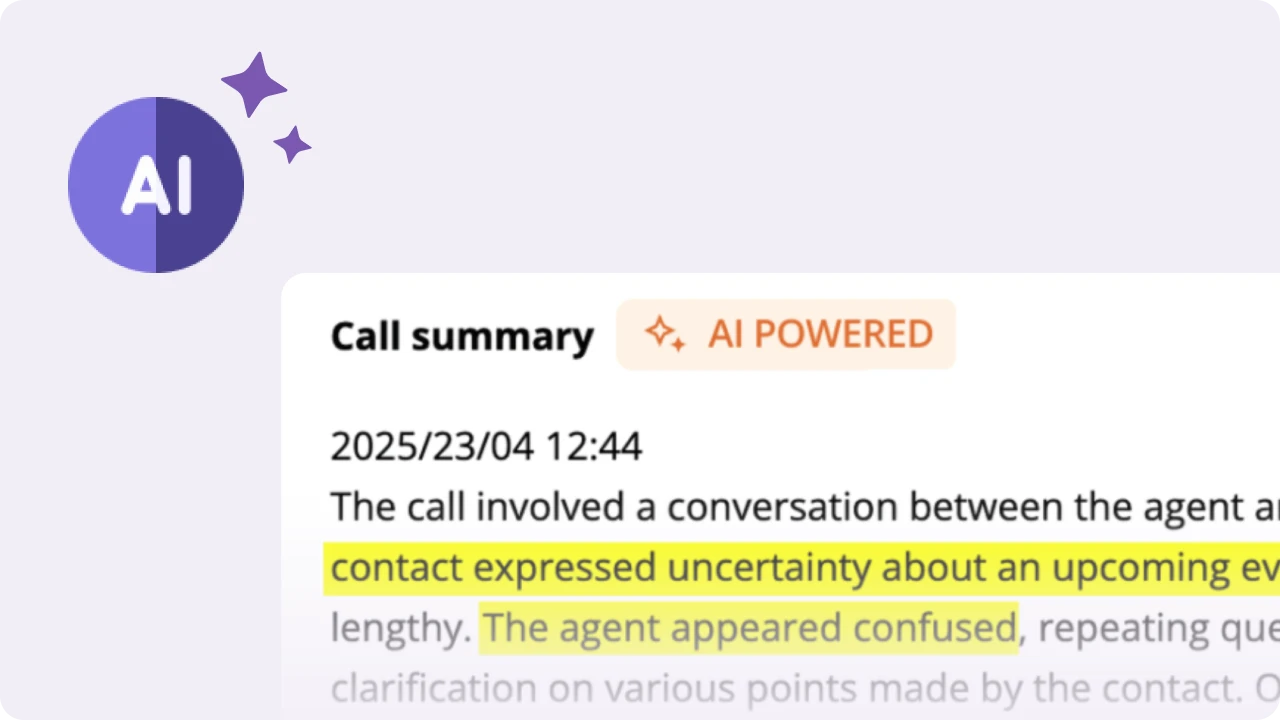Table of Contents
In the 1890s, political outreach was a localized affair where voters physically traveled to the then-25th president, William McKinley’s house, to hear him speak, which gave rise to the famous “Front Porch Campaign.”
Fast forward to 2008, Barack Obama’s campaign navigated the web of digital organizations and social media outreach instead of waiting for voters to come to him. His campaign success hinged on the ability to reach millions of Americans by making social media a political tool.
Today, the curve has shifted once again. With the rise of artificial intelligence and big data analytics, the game of influencing public perception is evolving faster than ever.
Let’s look at the hows and whys of political campaign management and trends you can adopt for your campaigns today!
What is political campaign management?
In simple terms, political campaign management is strategizing, organizing, and executing the campaign to win elections. As times evolve and new strategies like micro-targeting and digital media come into play, campaign management shifts to much more sophisticated operations driven by analytics and, yes, psychology!
What happens in political campaigns?
From grassroots movements to billion-dollar presidential bids, political campaigns are a high-stakes battle to win over the voters. Behind every phone call, ad, and rally is a meticulously planned effort to sway public opinion and mobilize supporters.
1. Data gathering and management
A successful campaign starts with data – loads of it. This is how they know exactly:
- how viable and winnable is a contender,
- who are the different groups of voters, and what are their motivations
- what to say to different groups of voters,
- where to say those things.
It’s all data, data, data. Once the data is collected, CRMs like NGP VAN and Nation Builder are used to organize and analyze the information gathered. Instead of sending the same repeated messages, campaign managers customize the approach based on what different voters care about.
How do you think Obama was able to reach millions of people in the 2012 election? The team launched a project called ‘Narwhal,’ a sophisticated system that his political campaign managers used along with micro-targeting to find persuadable voters and send personalized outreach. This, in turn, helped increase voter turnout in key swing states, making a big difference in the election.
2. Field organizing
Field organizing in political campaign management means recruiting and training volunteers for campaign-related initiatives. It is grassroots campaign mobilization involving building and managing a network of volunteers and staff who engage directly with voters through various methods such as door-to-door canvassing, phonebanking, voter registration drives, and community organizing.
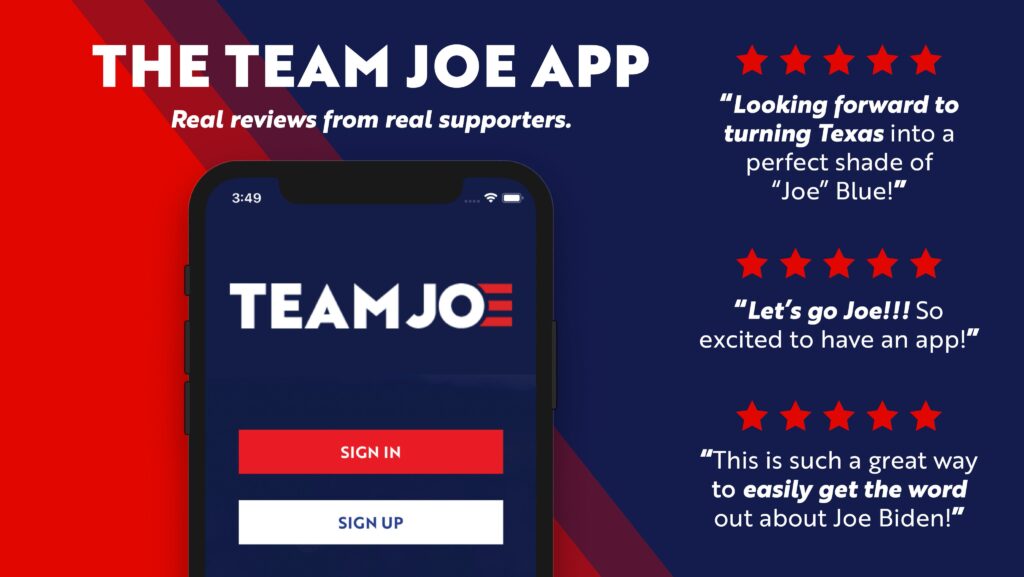
During the 2020 election, amidst the COVID-19 pandemic, Joe Biden’s team developed an extensive virtual field program that generated more than 54.9 million monthly views across social media platforms. They also launched the “Team Joe” app that sends mass text messages to GOTV. The team quickly adapted to the shift compared to the opposition – Donald Trump, whose downplaying of the pandemic didn’t gain much support from the voters.
If you have what it takes to be a field organizer, look no further than this blog: Inside the World of a Field Organizer.
3. Voter outreach
Voter outreach happens in several stages:
- Voter identification: campaigns identify supporters, persuadable voters, and opposition to focus efforts where they matter the most.
- Voter registration: It is essential to ensure that supporters are registered to vote. Campaigns run registration drives and often use digital tools to make the process easier. Here’s how you can organize a voter registration drive today.
- Get out the vote (GOTV): GOTV is the final push towards delivery before election day. This is where the GOTV efforts are put to ensure voters actually appear at the poll.
Read more to understand the idea behind Get Out The Vote (GOTV) campaigns.
4. Phone banking and text banking
In political campaign management, direct voter contact, such as phone and text banking, is vital for winning elections.
Phone banking
It’s more than just dialing.
Here is how phone banking in political campaigns works. Campaign volunteers call voters to discuss key issues, encourage voter participation, and answer questions. Calls can either be scripted or conversational, depending on the campaign’s strategy. The calls are the personal touch that persuades voters and mobilizes supporters who need the extra push to get to the polls.
With modern technology, phone banking software tools such as CallHub use sophisticated dialers for every type of campaign to make tens of thousands of calls within an hour. These dialers include:
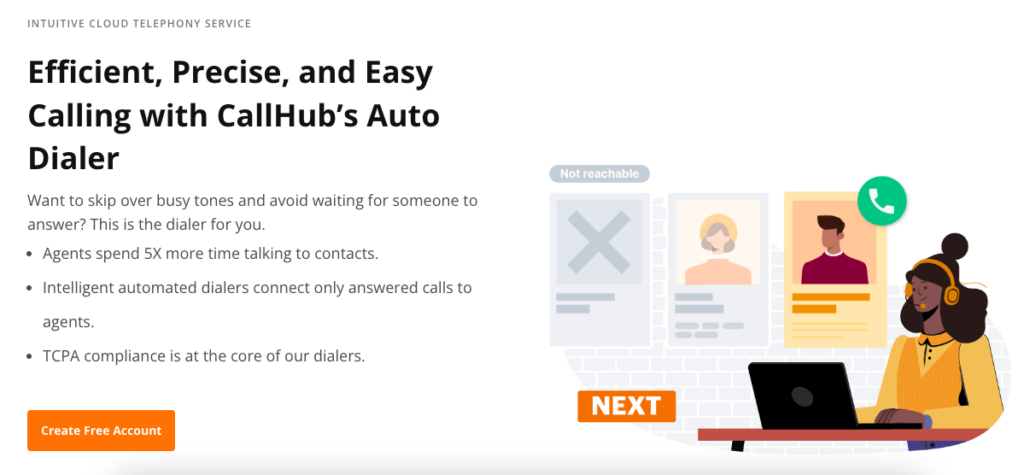
- Auto dialer: an automated system that streamlines outbound calls by dialing numbers and connecting answered calls to agents.
- Predictive dialer: Automatically dials multiple numbers, connecting agents only to answered calls to maximize efficiency. This is a great option when you need to get through larger lists quickly.
- Power dialer: Dials one number at a time, automatically calling the next after a call ends or is unanswered. This is a great option for when you want to add notes or surveys since it gives your agents time to add these details before the next call.
- Fastclick dialer: instantly dials numbers with a single click, enabling rapid outbound calling for high-volume campaigns.
In an era dominated by the internet and social media, the 2020 election showed the enduring power of direct communication, where 32% of voter outreach was carried out through personalized phone calls from live persons, while 48% was through pre-recorded messages.
This shows the continued importance of telephonic outreach in political campaigns and is a testament to how campaigns blend technology with personal interaction to maximize voter impact.
Young voters were reached out less by political campaigners than older voters through printed mail, email, or phone calls. Refer to the below image for a clearer understanding.
Make your calls count with CallHub’s phone banking services.
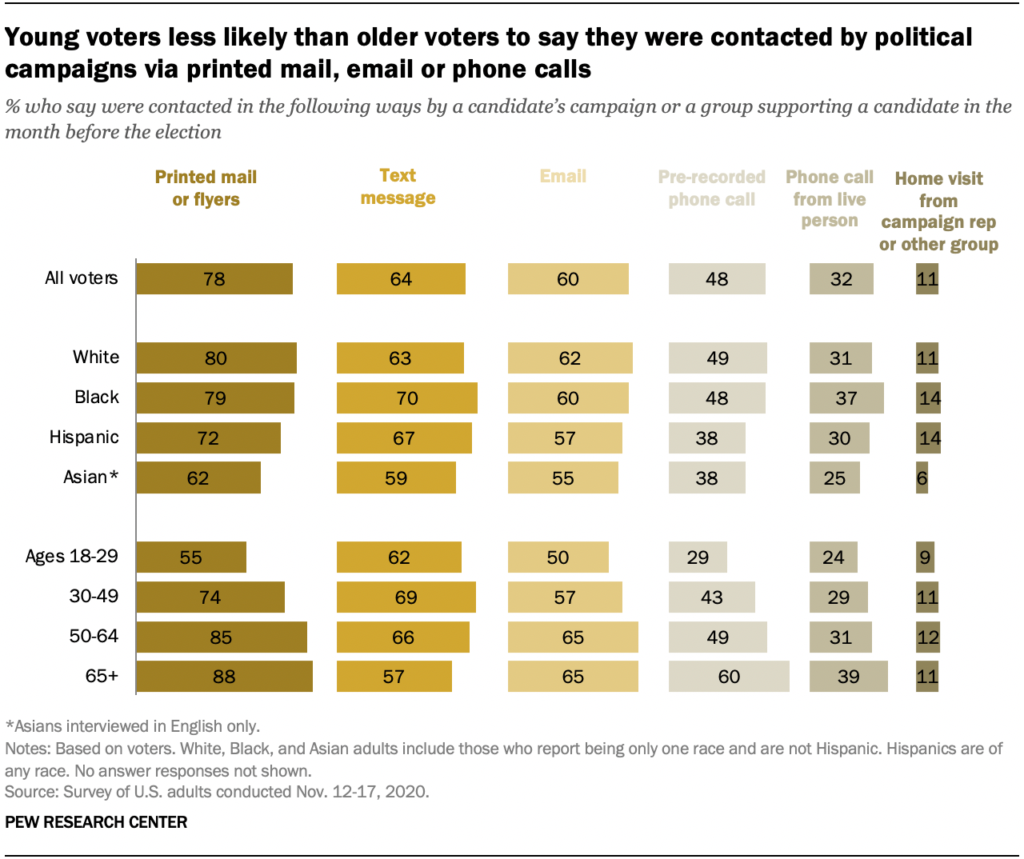
Text banking
Text banking uses a variety of ways to engage voters:
- Text broadcasts: Helps engage with voters through mass texting service.
- Peer-to-peer text messaging: It is ideal for two-way conversations with voters, donors and supporters
- MMS: It uses HD video, gifs, images, etc, that are more interactive and gain higher click-through rates for campaigns.
- RCS (rich communication services): allows users to send and receive high-quality media, create group chats, and see read receipts.
With an average attention span of eight seconds, Gen Z and many others prefer texts over calls. A well-crafted message can quickly capture their attention and engage them effectively. Along with the phone calls, 64% of Americans were reached through text messages from both parties, signifying the increasing importance of text banking as an attractive voter registration tool.
5. Public appearances
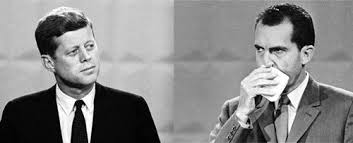
Do you remember the 1960 Kennedy-Nixon debate? One of the most discussed issues in the debate was that people who watched it on television were likelier to vote for Kennedy than Nixon because of the poised demeanor with which Kennedy appeared. Over the years, the desire for a candidate to look as good as they speak became more relevant.
Public appearances now extend to media interviews and podcasts, where candidates must navigate tough questions while projecting confidence and relatability.
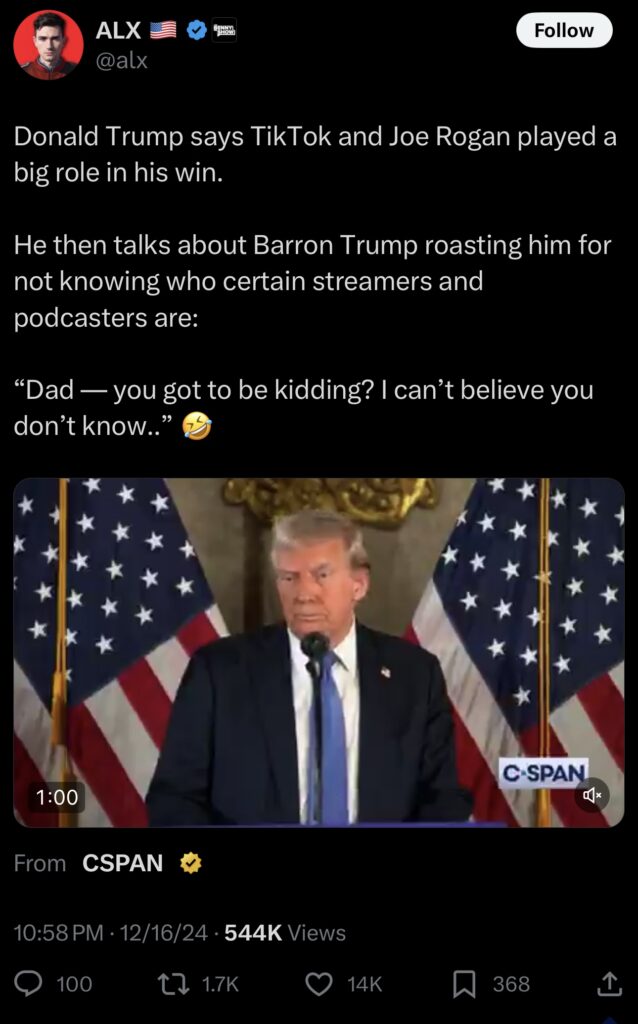
In October of 2024, during his presidential campaign, Donald Trump appeared on “The Joe Rogan Experience,” engaging in a nearly three-hour conversation with the podcast host and generating 40 million views in just three days on YouTube. Such podcast appearances contributed to Trump’s election success by presenting him as more relatable to voters.
5. Digital campaigning
With voters increasingly turning to online platforms for news, discussions, and engagements, political campaigns must adapt to meet them where the audiences are. Digital campaigning is an essential pillar of political campaign management. Here are the different ways in which it works:
- Social media: Platforms like X (Twitter), Facebook, and TikTok help candidates communicate directly with voters.
- Website & email campaigns: A campaign website serves as a hotbed for policies, volunteer sign-ups, and donations.
- TV & Online Ads: Paid television, YouTube, podcasts, and social media advertisements help control campaign messaging.
- Influencer relations: Social media influencers, bloggers, and public figures amplify a campaign’s reach, build trust, and drive discussions among their followers.
6. Fundraising efforts
Let’s face the reality here. A campaign needs money – and lots of it. Fundraising efforts range from small donations to high-dollar events with wealthy donors. Online fundraising has skyrocketed recently, with platforms like ActBlue and WinRed enabling candidates to raise millions in small donations.
For example, during the 2024 presidential election, Kamala Harris’s team raised more than $81 million in the 24-hour period after Joe Biden dropped out of the race. This was the largest single-day total in the country’s history. Campaign managers can also work in tandem with PACs to direct use of funds. Political Action Committees (PACs) raise and donate money to candidates. However, they can only give up to $5,000 per candidate. Super PACs, on the other hand, can raise and spend unlimited funds. However, they cannot donate directly to candidates or coordinate with campaigns.
This has made Super PACs powerful in elections. They fund massive ad campaigns and voter outreach efforts. In 2024, new rules allowed closer ties between campaigns and PACs. This blurred the lines even further.
Groups like Priorities USA Action, America First Action, and Senate Leadership Fund have used this freedom to shape political narratives. Their influence has grown like never before. With PACs and Super PACs playing a bigger role, the right technology is key to securing funds.
7. Public relations
A candidate’s public image can make or break a campaign in political campaign management. Whether handling a scandal or amplifying a key message, public relations in politics shape perception.
During the 2008 election, Obama’s presidential campaign launched a website called “Fight the Smears,” where they responded to continuing viral efforts to smear Obama’s name. A great tactic not only to avoid a negative public image but also to strengthen his voters’ support. This is how public relations works in politics.
Who manages campaign operations?
Political campaign management is spearheaded by a political campaign manager. Let’s take a look at their responsibilities.
Political campaign manager
They are the beating hearts of any campaign, juggling everything from strategy to crisis management – and yes, occasionally putting out fires (metaphorically speaking, of course!). Their expertise is essential for transforming political aspirations into electoral victories.
Key responsibilities of a political campaign manager
Political campaign managers oversee a variety of campaign initiatives. Often, there are experts and other senior team members guiding their decisions, but the buck stops with the campaign manager.
- Develop the campaign strategy:
At the heart of any political campaign is a well-thought-out strategy. A campaign manager works closely with the candidate and advisors to define the campaign’s message, policy priorities, and target voter base. They analyze political scenarios, voter demographics, and tactics to achieve electoral victory.
- Shaping messages for target audiences:
Crafting the right message is critical in swaying public opinion. The campaign manager works closely with communication teams to develop speeches, social media content, press releases, and advertisements. They tailor messages for different voter segments, ensuring the campaign resonates with diverse audiences.
- Managing campaign budgets:
Managing a budget isn’t easy. The political campaign managers strategically plan every financial decision, from advertising expenses to campaign rallies. Political campaign managers do it all to maintain a balanced budget and oversee fundraising efforts, donor engagement, and event sponsorships..
Sounds like a lot, doesn’t it? Worry not because CallHub is here to help you create a winning political budget.
- Hiring and overseeing campaign staff:
Creating a campaign team is like assembling the Avengers of politics, and the campaign manager is Nick Fury of the operations – recruiting the best talent, keeping everyone motivated, and making sure everyone’s rowing in the same direction. Political campaign managers are part HR wizard, part motivational coach, and part strategic mastermind.
Now that you have understood the responsibilities of political campaign managers, are you curious about political campaign careers as a manager your calling? Here are some fresh job and volunteer opportunities you can look into.
The masterminds behind a campaign operation are a group of coffee-fueled wizards where the campaign manager takes the helm, working with:
- Field director: who gets boots on the ground and voters fired up.
- Communications director who makes sure the message stays on the point.
- Fundraising coordinator responsible for developing and implementing effective fundraising strategies for the necessary financial resources.
- Digital team, which maximizes online presence and engagement with the growing importance of digital marketing in political campaigns; digital team makes comprehensive online outreach plan.
Read more: Political marketing campaigns.
Volunteers and consultants are key in this operation’s voter outreach, data analysis, and communications.
Ready for your political campaign management journey?
Campaign management isn’t just a job – it’s a calling. If you thrive on strategy, embrace challenges, and believe in the power of a passionate team, this path is for you.
Success isn’t just about winning; it’s about making a difference. Learn the skills, build your network, and understand the voters. Pro tip? The best campaign managers aren’t just strategists – they’re storytellers, motivators, and visionaries.
We have a set of guides to help you on your journey if you’re ready. You can begin with:


